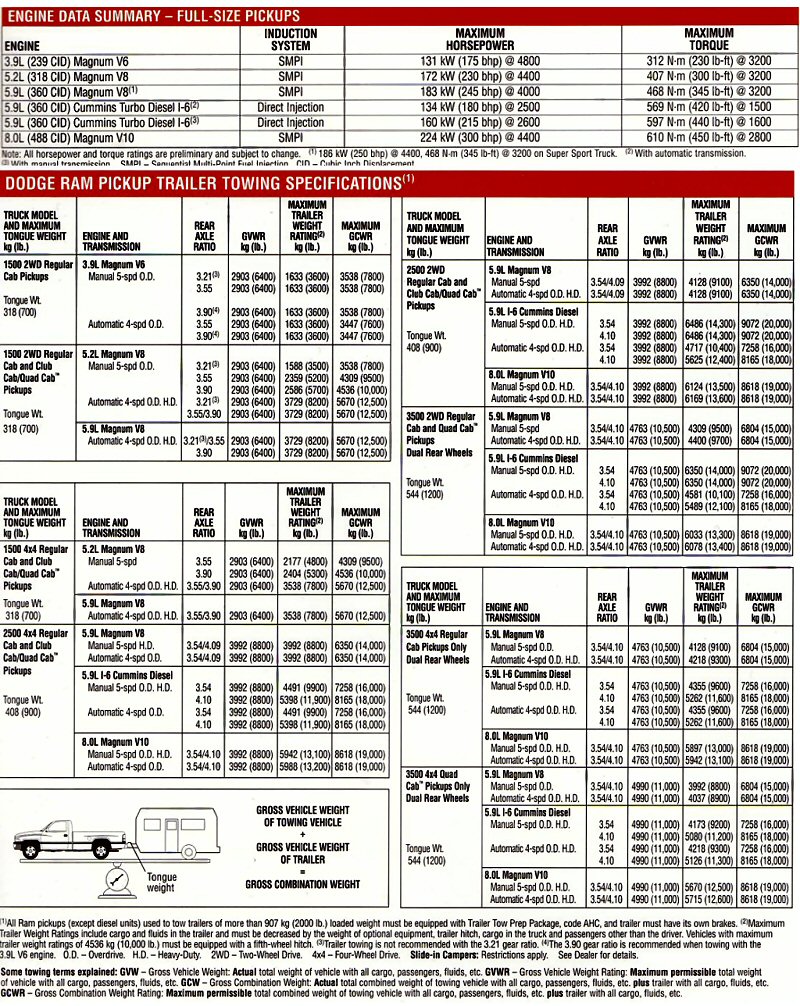|
Return to Tech; |
Towing Tips |
This info is from the official Dodge website.
Before you select a towing vehicle you need to determine the weight of the trailer being towed as well as the weight the vehicle will carry while towing. To make things easier and provide a good margin of safety, Dodge has created five classifications for trailer weights and hitches. Take a look at the breakdown of maximum weights for each class, typical trailer loads, and hitch requirements below. 2,000-pound maximum Folding camping trailers and trailers for small boats, motorcycles, and snowmobiles Load-carrying (non-equalizing) hitch 3,500-pound maximum Single-axle, small to medium length (up to 18 feet) trailers 5,000-pound maximum Dual-axle or large single-axle trailers Weight-distributing hitch not required, unless specified for a particular vehicle 12,000-pound maximum Largest travel trailers made for recreation Weight-distributing hitch is required; as indicated by each weight classification, there are
three types of hitches that are requiredOver 12,000-pounds Must be fifth-wheel or gooseneck
Before hitching up
- Keep trailer load as low as possible for a low center of gravity
- If the trailer/load exceeds 1,000 pounds, the trailer should have its own brake system
- Never overload a trailer - trailers have a gross vehicle or trailer weight rating which is usually found on a manufacturer's plate on the tongue. The total weight of trailer and load should be about 13 percent less than the gross vehicle or trailer weight rating for the trailer
- Load must be balanced from side to side, while 60 percent of the load should be in the front half and 40 percent in the rear half for a slight weight-forward bias
- Tongue weight, the amount of weight the trailer and its load will put on the hitch, should be at least 10 percent and less than 15 percent of the gross trailer weight
- King pin weight, the amount of weight the trailer and its load will put on a fifth wheel hitch, should be at least 15 percent and less than 25 percent of the gross trailer weight
- Trailer wiring should be in good working condition and the connection must match that of the tow vehicle
- Correct trailer and tow vehicle tire pressures are vital. Make sure trailer tire pressures conform to the manufacturer's recommendation on the plate located on the trailer tongue. Tow vehicle tire pressure recommendations are found on the tire inflation pressure chart in the information package with your Owner's Manual, or ask your dealer
- Make sure the trailer's hitch connection is in proper working order
- Make sure the tow vehicle's hitch, hitch receiver, and ball are in proper working order and fastened tightly
- Make sure your tow vehicle mirrors meet legal requirements and provide you with as much rearward vision as possible
Hitching up
- Make sure all hitch, electrical, and brake system connections (if appropriate) are tight and locked
- Lock down the hitch coupler and secure with a bolt or locking pin
- Properly attach safety chains to the hitch receiver
- Check tow vehicle and trailer lights
- Check brakes by starting and stopping several times
- Adjust tow vehicle mirrors for the best possible view of the trailer's outside edges
Going down the road
- Starting up, accelerate slowly and surely
- When moving, avoid sudden moves that may cause the trailer to yaw from side to side
- When making turns, allow more room on the inside of turns for the trailer to clear
- When passing …
- Pass only on level road surfaces
- Allow extra room to clear passed vehicles
- Again, don't make abrupt moves when passing
- Tow vehicle performance and trailer load may make it necessary to downshift to a lower gear when passing for better acceleration
- Downshifting adds power on upgrades and control on downgrades by using engine compression for additional braking power
When you have an automatic transmission with overdrive
- In hilly areas and with heavy loads, it is recommended you lock the transmission "out" of overdrive to prevent excessive gear shifting
- Overdrive can be locked out to promote engine braking on downgrades
- Use overdrive with lighter loads and in flat terrain to increase fuel efficiency
With Electronic Speed Control
- Don't use in hilly terrain or with heavy loads
- When using the speed control, if you experience speed drops greater than 10 mph, disengage until you can get back to cruising speed
- Use speed control in flat terrain and with light loads to maximize fuel efficiency
Parking
- Avoid parking on grades
- When parking, lock the tow vehicle down with the parking brake, put the tow vehicle automatic transmission in P for Park, with a manual transmission, shift the transmission into reverse and with four-wheel-drive vehicles, make sure the transfer case is not in neutral, and always, block or "chock" the trailer wheels
- Have a guide
- Whenever possible, have an observer outside of the vehicle and trailer and visible to you at the wheel, especially when backing and parking
98 Ram Engine Availability & Trailer Tow Ratings
(scanned from 98 Ram brochure)




